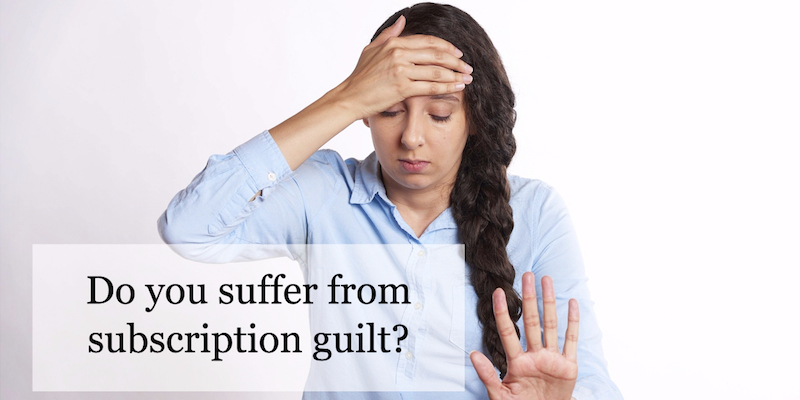I was having a comment conversation with Robbie Kellman Baxter the other day and…
Wait – you don’t know what a comment conversation is?
It’s what writers do when they start exchanging ideas and stories in the comments of a blog post, because they’re too lazy to pick up the phone and call, and are more comfortable writing.
Anyway, Robbie (the author of The Membership Economy) wrote a terrific blog post about Blue Apron and the other meal kit companies. In the post, she mentions how the meal kit subscription model “puts undue pressure on the subscriber.”
Her comment about “undue pressure” sparked our comment conversation. She shared a story of a neighbor who turned down a dinner invitation because he had to go home and cook the Blue Apron meal waiting there.
That got me thinking about what happens when we can’t live up to our subscriptions. I’ve written in the past about Subscription Fatigue, but this is something different. Let’s call it Subscription Guilt.
Subscription Guilt
Subscription guilt is what happens when the reality of our daily life clashes with our commitment to a subscription, and we make decisions to alleviate that conflict:
I’d go to the movies, but I just upgraded my Netflix so should watch more.
I’d eat dinner with Robbie, but I’ve got to cook that meal box.
Suddenly, our reason for subscribing (convenience, fun) has morphed into something else (obligation, hassle).
Some subscriptions are more prone to guilt than others.
For example, when we subscribe to a vegetable box, we may count on the subscription to inspire us to eat more vegetables. Or, we sign up for a gym membership in hopes of working out more. (I paid, I really should go.)
In those situations, a bit of guilt might be a good thing. The guilt trip may be part of the value proposition, as your rational, forward-thinking self tries to outsmart your lazy, couch potato self.
But if the subscription value proposition is fun, convenience, cost savings, identity, or entertainment, then guilt can be a problem.
Are You Burdening Your Subscribers?
If you sell or market a subscription service, think about the effect your subscription has on a customer over time, after the initial excitement has waned.
Is it possible that you’re inducing subscription guilt? And if so, you can you mitigate that feeling, and keep the subscriber contented and guilt-free?
Perhaps you can offer more flexible delivery options, or the ability to dial back briefly on delivery or share a subscription with someone else for a time. Maybe offer a “vacation” setting that lets people pause and then restart, to accommodate shifting life circumstances.
You might lose a bit of short-term revenue through these offers, but keep the long-term subscriber. And that’s nearly always a better deal for your ongoing growth and revenue.
Want to Hear More?
Check out Robbie’s LinkedIn video on Subscription Guilt – and join in the comment conversation there as well!
